Mergers Case Study: BioHealth-De Waal, Leadership & Integration Issues
VerifiedAdded on 2023/06/05
|11
|2961
|198
Case Study
AI Summary
This case study examines the proposed merger between De Waal, a pharmaceutical company from the Netherlands, and BioHealth, a pharmaceutical giant based in New York. The merger aims to achieve economies of scale and leverage talent from both organizations. However, emerging issues such as employee concerns about job security and cultural disparities threaten the success of the integration. The case highlights conflicting issues related to leadership, communication, and decision-making processes. It critiques the approaches of Steve, the CEO of BioHealth, and Kaspar, the chairman of De Waal, in managing the merger. Recommendations are provided for improving communication, accelerating the integration process, and addressing cultural differences to ensure a successful merger outcome. The analysis emphasizes the importance of transparent communication, strategic decision-making, and cultural sensitivity in merger integrations. Desklib offers similar case studies and solved assignments for students.

Running head: MERGERS 1
Mergers
Student’s Name
Institution Affiliation
Date
Mergers
Student’s Name
Institution Affiliation
Date
Paraphrase This Document
Need a fresh take? Get an instant paraphrase of this document with our AI Paraphraser
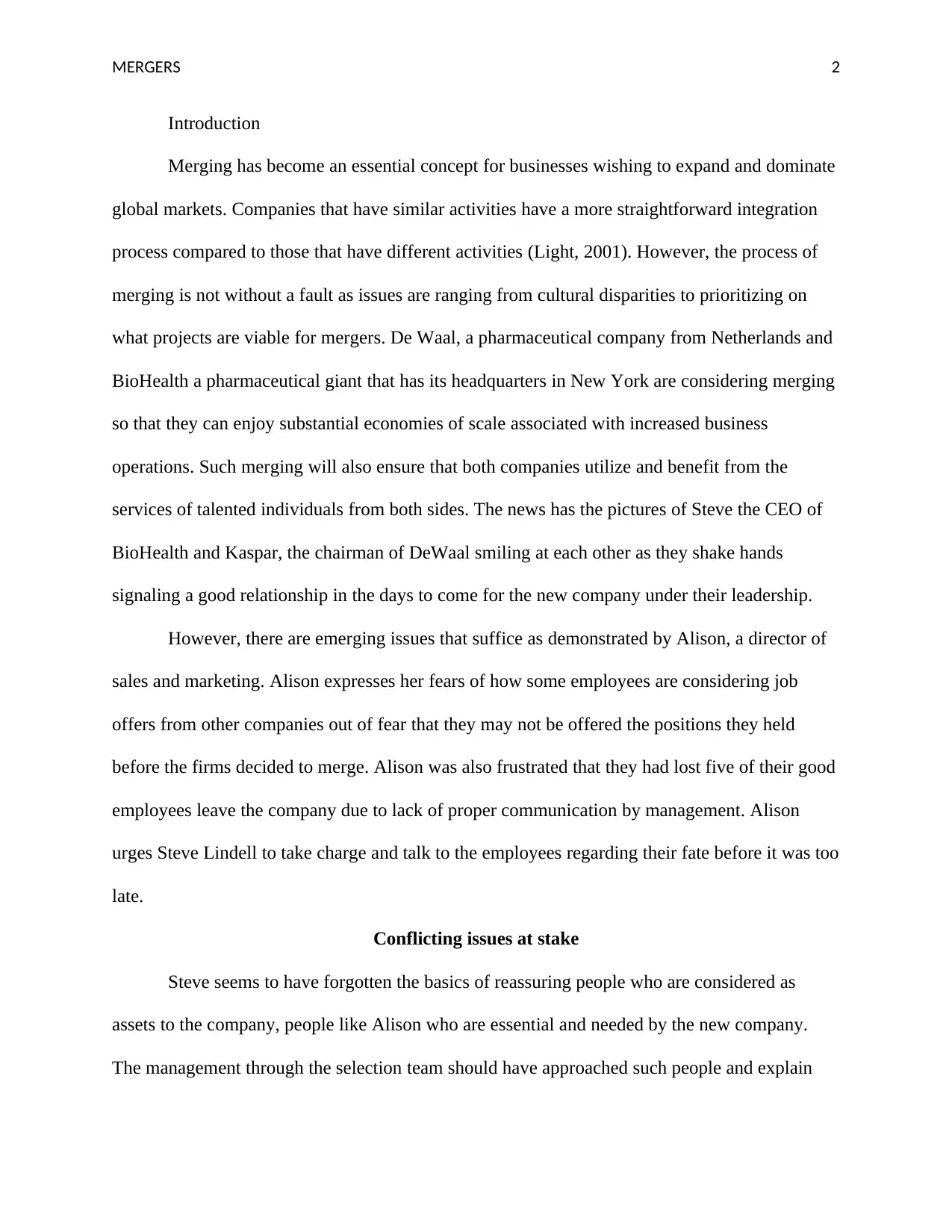
MERGERS 2
Introduction
Merging has become an essential concept for businesses wishing to expand and dominate
global markets. Companies that have similar activities have a more straightforward integration
process compared to those that have different activities (Light, 2001). However, the process of
merging is not without a fault as issues are ranging from cultural disparities to prioritizing on
what projects are viable for mergers. De Waal, a pharmaceutical company from Netherlands and
BioHealth a pharmaceutical giant that has its headquarters in New York are considering merging
so that they can enjoy substantial economies of scale associated with increased business
operations. Such merging will also ensure that both companies utilize and benefit from the
services of talented individuals from both sides. The news has the pictures of Steve the CEO of
BioHealth and Kaspar, the chairman of DeWaal smiling at each other as they shake hands
signaling a good relationship in the days to come for the new company under their leadership.
However, there are emerging issues that suffice as demonstrated by Alison, a director of
sales and marketing. Alison expresses her fears of how some employees are considering job
offers from other companies out of fear that they may not be offered the positions they held
before the firms decided to merge. Alison was also frustrated that they had lost five of their good
employees leave the company due to lack of proper communication by management. Alison
urges Steve Lindell to take charge and talk to the employees regarding their fate before it was too
late.
Conflicting issues at stake
Steve seems to have forgotten the basics of reassuring people who are considered as
assets to the company, people like Alison who are essential and needed by the new company.
The management through the selection team should have approached such people and explain
Introduction
Merging has become an essential concept for businesses wishing to expand and dominate
global markets. Companies that have similar activities have a more straightforward integration
process compared to those that have different activities (Light, 2001). However, the process of
merging is not without a fault as issues are ranging from cultural disparities to prioritizing on
what projects are viable for mergers. De Waal, a pharmaceutical company from Netherlands and
BioHealth a pharmaceutical giant that has its headquarters in New York are considering merging
so that they can enjoy substantial economies of scale associated with increased business
operations. Such merging will also ensure that both companies utilize and benefit from the
services of talented individuals from both sides. The news has the pictures of Steve the CEO of
BioHealth and Kaspar, the chairman of DeWaal smiling at each other as they shake hands
signaling a good relationship in the days to come for the new company under their leadership.
However, there are emerging issues that suffice as demonstrated by Alison, a director of
sales and marketing. Alison expresses her fears of how some employees are considering job
offers from other companies out of fear that they may not be offered the positions they held
before the firms decided to merge. Alison was also frustrated that they had lost five of their good
employees leave the company due to lack of proper communication by management. Alison
urges Steve Lindell to take charge and talk to the employees regarding their fate before it was too
late.
Conflicting issues at stake
Steve seems to have forgotten the basics of reassuring people who are considered as
assets to the company, people like Alison who are essential and needed by the new company.
The management through the selection team should have approached such people and explain
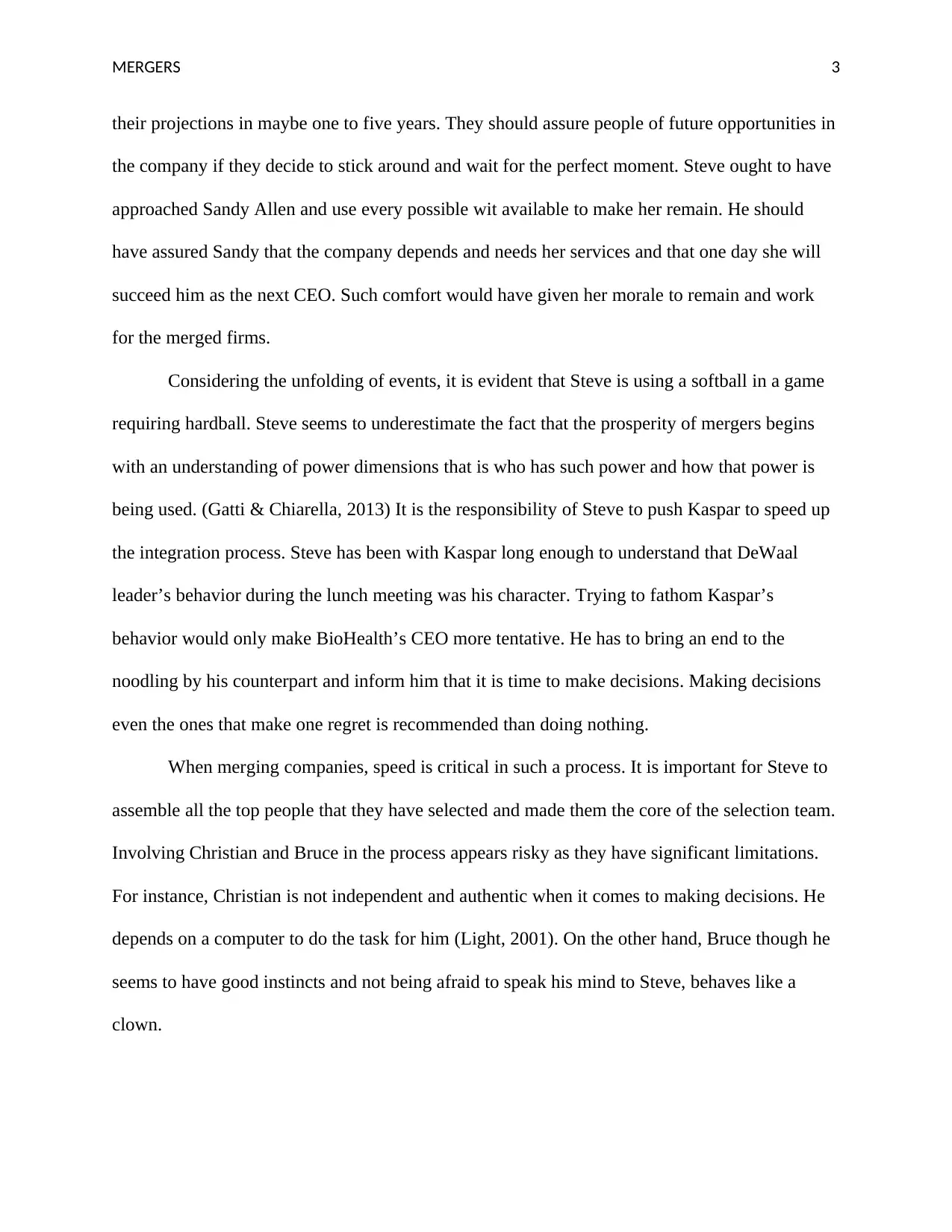
MERGERS 3
their projections in maybe one to five years. They should assure people of future opportunities in
the company if they decide to stick around and wait for the perfect moment. Steve ought to have
approached Sandy Allen and use every possible wit available to make her remain. He should
have assured Sandy that the company depends and needs her services and that one day she will
succeed him as the next CEO. Such comfort would have given her morale to remain and work
for the merged firms.
Considering the unfolding of events, it is evident that Steve is using a softball in a game
requiring hardball. Steve seems to underestimate the fact that the prosperity of mergers begins
with an understanding of power dimensions that is who has such power and how that power is
being used. (Gatti & Chiarella, 2013) It is the responsibility of Steve to push Kaspar to speed up
the integration process. Steve has been with Kaspar long enough to understand that DeWaal
leader’s behavior during the lunch meeting was his character. Trying to fathom Kaspar’s
behavior would only make BioHealth’s CEO more tentative. He has to bring an end to the
noodling by his counterpart and inform him that it is time to make decisions. Making decisions
even the ones that make one regret is recommended than doing nothing.
When merging companies, speed is critical in such a process. It is important for Steve to
assemble all the top people that they have selected and made them the core of the selection team.
Involving Christian and Bruce in the process appears risky as they have significant limitations.
For instance, Christian is not independent and authentic when it comes to making decisions. He
depends on a computer to do the task for him (Light, 2001). On the other hand, Bruce though he
seems to have good instincts and not being afraid to speak his mind to Steve, behaves like a
clown.
their projections in maybe one to five years. They should assure people of future opportunities in
the company if they decide to stick around and wait for the perfect moment. Steve ought to have
approached Sandy Allen and use every possible wit available to make her remain. He should
have assured Sandy that the company depends and needs her services and that one day she will
succeed him as the next CEO. Such comfort would have given her morale to remain and work
for the merged firms.
Considering the unfolding of events, it is evident that Steve is using a softball in a game
requiring hardball. Steve seems to underestimate the fact that the prosperity of mergers begins
with an understanding of power dimensions that is who has such power and how that power is
being used. (Gatti & Chiarella, 2013) It is the responsibility of Steve to push Kaspar to speed up
the integration process. Steve has been with Kaspar long enough to understand that DeWaal
leader’s behavior during the lunch meeting was his character. Trying to fathom Kaspar’s
behavior would only make BioHealth’s CEO more tentative. He has to bring an end to the
noodling by his counterpart and inform him that it is time to make decisions. Making decisions
even the ones that make one regret is recommended than doing nothing.
When merging companies, speed is critical in such a process. It is important for Steve to
assemble all the top people that they have selected and made them the core of the selection team.
Involving Christian and Bruce in the process appears risky as they have significant limitations.
For instance, Christian is not independent and authentic when it comes to making decisions. He
depends on a computer to do the task for him (Light, 2001). On the other hand, Bruce though he
seems to have good instincts and not being afraid to speak his mind to Steve, behaves like a
clown.
⊘ This is a preview!⊘
Do you want full access?
Subscribe today to unlock all pages.

Trusted by 1+ million students worldwide
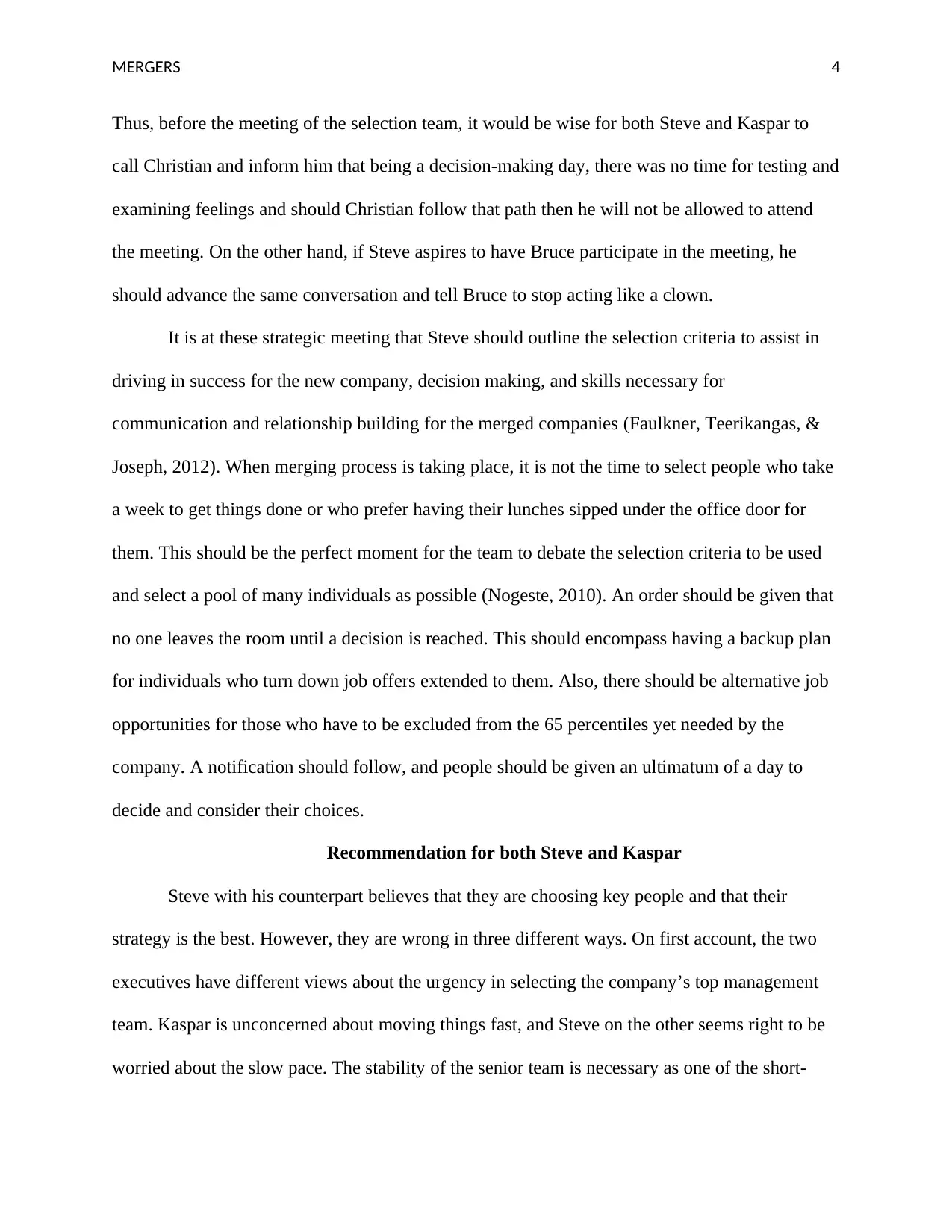
MERGERS 4
Thus, before the meeting of the selection team, it would be wise for both Steve and Kaspar to
call Christian and inform him that being a decision-making day, there was no time for testing and
examining feelings and should Christian follow that path then he will not be allowed to attend
the meeting. On the other hand, if Steve aspires to have Bruce participate in the meeting, he
should advance the same conversation and tell Bruce to stop acting like a clown.
It is at these strategic meeting that Steve should outline the selection criteria to assist in
driving in success for the new company, decision making, and skills necessary for
communication and relationship building for the merged companies (Faulkner, Teerikangas, &
Joseph, 2012). When merging process is taking place, it is not the time to select people who take
a week to get things done or who prefer having their lunches sipped under the office door for
them. This should be the perfect moment for the team to debate the selection criteria to be used
and select a pool of many individuals as possible (Nogeste, 2010). An order should be given that
no one leaves the room until a decision is reached. This should encompass having a backup plan
for individuals who turn down job offers extended to them. Also, there should be alternative job
opportunities for those who have to be excluded from the 65 percentiles yet needed by the
company. A notification should follow, and people should be given an ultimatum of a day to
decide and consider their choices.
Recommendation for both Steve and Kaspar
Steve with his counterpart believes that they are choosing key people and that their
strategy is the best. However, they are wrong in three different ways. On first account, the two
executives have different views about the urgency in selecting the company’s top management
team. Kaspar is unconcerned about moving things fast, and Steve on the other seems right to be
worried about the slow pace. The stability of the senior team is necessary as one of the short-
Thus, before the meeting of the selection team, it would be wise for both Steve and Kaspar to
call Christian and inform him that being a decision-making day, there was no time for testing and
examining feelings and should Christian follow that path then he will not be allowed to attend
the meeting. On the other hand, if Steve aspires to have Bruce participate in the meeting, he
should advance the same conversation and tell Bruce to stop acting like a clown.
It is at these strategic meeting that Steve should outline the selection criteria to assist in
driving in success for the new company, decision making, and skills necessary for
communication and relationship building for the merged companies (Faulkner, Teerikangas, &
Joseph, 2012). When merging process is taking place, it is not the time to select people who take
a week to get things done or who prefer having their lunches sipped under the office door for
them. This should be the perfect moment for the team to debate the selection criteria to be used
and select a pool of many individuals as possible (Nogeste, 2010). An order should be given that
no one leaves the room until a decision is reached. This should encompass having a backup plan
for individuals who turn down job offers extended to them. Also, there should be alternative job
opportunities for those who have to be excluded from the 65 percentiles yet needed by the
company. A notification should follow, and people should be given an ultimatum of a day to
decide and consider their choices.
Recommendation for both Steve and Kaspar
Steve with his counterpart believes that they are choosing key people and that their
strategy is the best. However, they are wrong in three different ways. On first account, the two
executives have different views about the urgency in selecting the company’s top management
team. Kaspar is unconcerned about moving things fast, and Steve on the other seems right to be
worried about the slow pace. The stability of the senior team is necessary as one of the short-
Paraphrase This Document
Need a fresh take? Get an instant paraphrase of this document with our AI Paraphraser
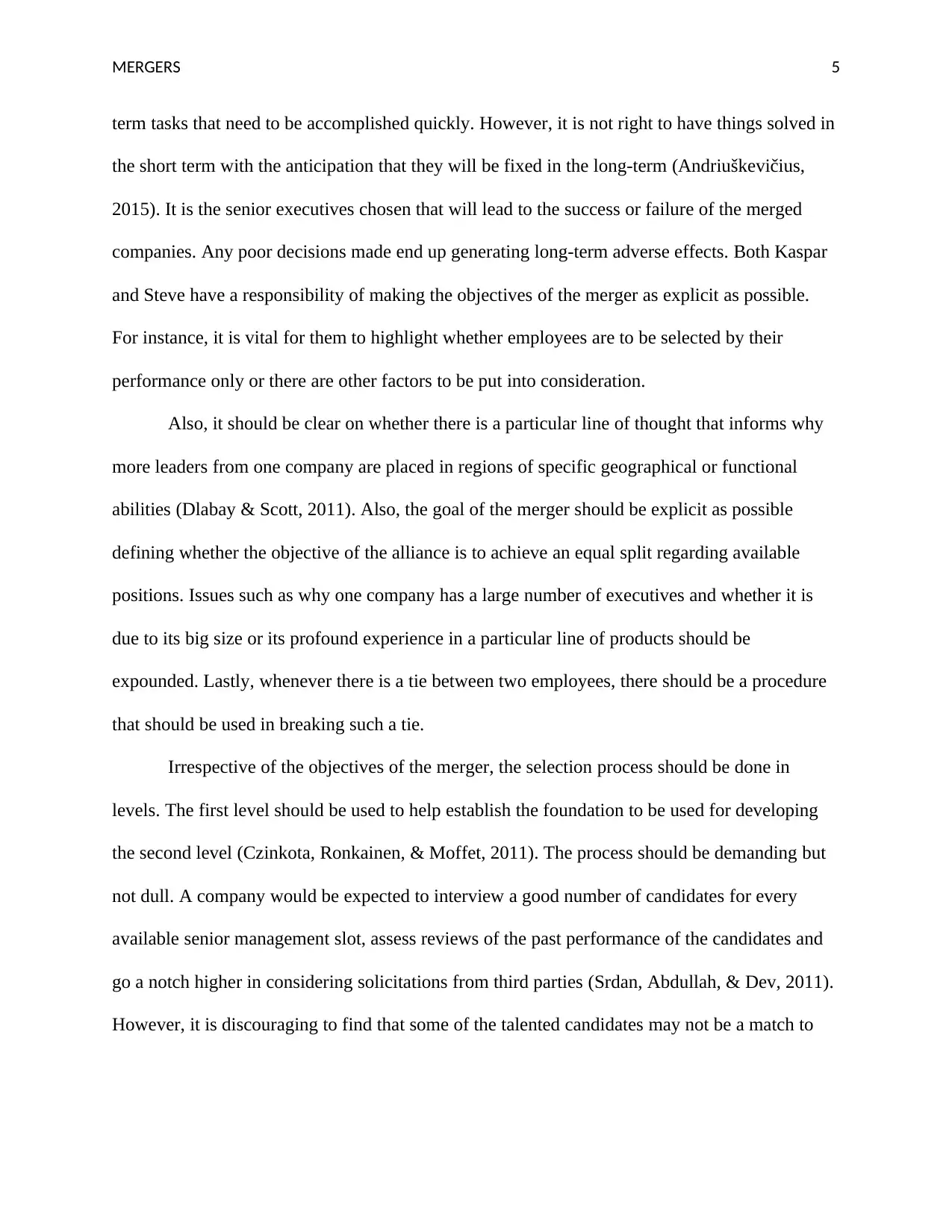
MERGERS 5
term tasks that need to be accomplished quickly. However, it is not right to have things solved in
the short term with the anticipation that they will be fixed in the long-term (Andriuškevičius,
2015). It is the senior executives chosen that will lead to the success or failure of the merged
companies. Any poor decisions made end up generating long-term adverse effects. Both Kaspar
and Steve have a responsibility of making the objectives of the merger as explicit as possible.
For instance, it is vital for them to highlight whether employees are to be selected by their
performance only or there are other factors to be put into consideration.
Also, it should be clear on whether there is a particular line of thought that informs why
more leaders from one company are placed in regions of specific geographical or functional
abilities (Dlabay & Scott, 2011). Also, the goal of the merger should be explicit as possible
defining whether the objective of the alliance is to achieve an equal split regarding available
positions. Issues such as why one company has a large number of executives and whether it is
due to its big size or its profound experience in a particular line of products should be
expounded. Lastly, whenever there is a tie between two employees, there should be a procedure
that should be used in breaking such a tie.
Irrespective of the objectives of the merger, the selection process should be done in
levels. The first level should be used to help establish the foundation to be used for developing
the second level (Czinkota, Ronkainen, & Moffet, 2011). The process should be demanding but
not dull. A company would be expected to interview a good number of candidates for every
available senior management slot, assess reviews of the past performance of the candidates and
go a notch higher in considering solicitations from third parties (Srdan, Abdullah, & Dev, 2011).
However, it is discouraging to find that some of the talented candidates may not be a match to
term tasks that need to be accomplished quickly. However, it is not right to have things solved in
the short term with the anticipation that they will be fixed in the long-term (Andriuškevičius,
2015). It is the senior executives chosen that will lead to the success or failure of the merged
companies. Any poor decisions made end up generating long-term adverse effects. Both Kaspar
and Steve have a responsibility of making the objectives of the merger as explicit as possible.
For instance, it is vital for them to highlight whether employees are to be selected by their
performance only or there are other factors to be put into consideration.
Also, it should be clear on whether there is a particular line of thought that informs why
more leaders from one company are placed in regions of specific geographical or functional
abilities (Dlabay & Scott, 2011). Also, the goal of the merger should be explicit as possible
defining whether the objective of the alliance is to achieve an equal split regarding available
positions. Issues such as why one company has a large number of executives and whether it is
due to its big size or its profound experience in a particular line of products should be
expounded. Lastly, whenever there is a tie between two employees, there should be a procedure
that should be used in breaking such a tie.
Irrespective of the objectives of the merger, the selection process should be done in
levels. The first level should be used to help establish the foundation to be used for developing
the second level (Czinkota, Ronkainen, & Moffet, 2011). The process should be demanding but
not dull. A company would be expected to interview a good number of candidates for every
available senior management slot, assess reviews of the past performance of the candidates and
go a notch higher in considering solicitations from third parties (Srdan, Abdullah, & Dev, 2011).
However, it is discouraging to find that some of the talented candidates may not be a match to
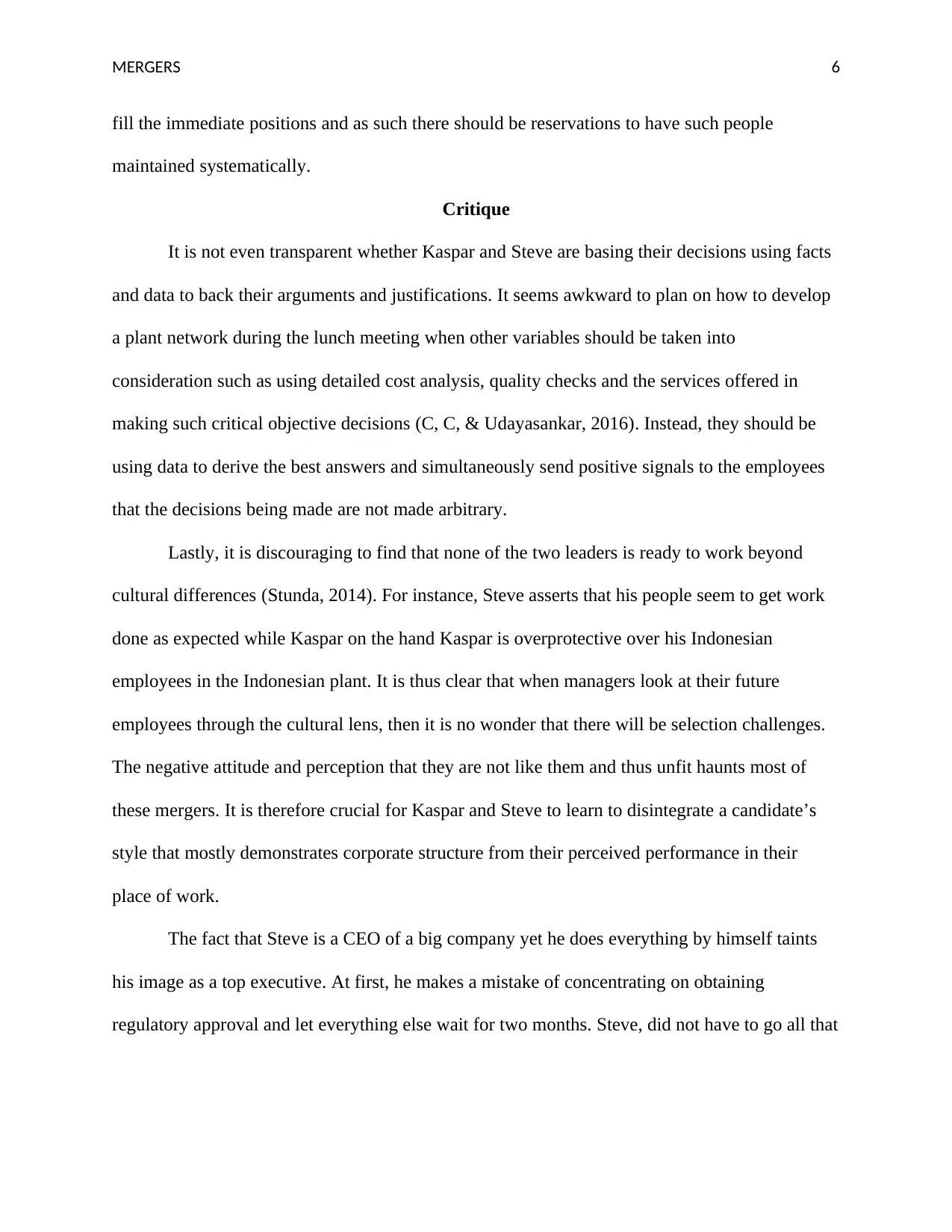
MERGERS 6
fill the immediate positions and as such there should be reservations to have such people
maintained systematically.
Critique
It is not even transparent whether Kaspar and Steve are basing their decisions using facts
and data to back their arguments and justifications. It seems awkward to plan on how to develop
a plant network during the lunch meeting when other variables should be taken into
consideration such as using detailed cost analysis, quality checks and the services offered in
making such critical objective decisions (C, C, & Udayasankar, 2016). Instead, they should be
using data to derive the best answers and simultaneously send positive signals to the employees
that the decisions being made are not made arbitrary.
Lastly, it is discouraging to find that none of the two leaders is ready to work beyond
cultural differences (Stunda, 2014). For instance, Steve asserts that his people seem to get work
done as expected while Kaspar on the hand Kaspar is overprotective over his Indonesian
employees in the Indonesian plant. It is thus clear that when managers look at their future
employees through the cultural lens, then it is no wonder that there will be selection challenges.
The negative attitude and perception that they are not like them and thus unfit haunts most of
these mergers. It is therefore crucial for Kaspar and Steve to learn to disintegrate a candidate’s
style that mostly demonstrates corporate structure from their perceived performance in their
place of work.
The fact that Steve is a CEO of a big company yet he does everything by himself taints
his image as a top executive. At first, he makes a mistake of concentrating on obtaining
regulatory approval and let everything else wait for two months. Steve, did not have to go all that
fill the immediate positions and as such there should be reservations to have such people
maintained systematically.
Critique
It is not even transparent whether Kaspar and Steve are basing their decisions using facts
and data to back their arguments and justifications. It seems awkward to plan on how to develop
a plant network during the lunch meeting when other variables should be taken into
consideration such as using detailed cost analysis, quality checks and the services offered in
making such critical objective decisions (C, C, & Udayasankar, 2016). Instead, they should be
using data to derive the best answers and simultaneously send positive signals to the employees
that the decisions being made are not made arbitrary.
Lastly, it is discouraging to find that none of the two leaders is ready to work beyond
cultural differences (Stunda, 2014). For instance, Steve asserts that his people seem to get work
done as expected while Kaspar on the hand Kaspar is overprotective over his Indonesian
employees in the Indonesian plant. It is thus clear that when managers look at their future
employees through the cultural lens, then it is no wonder that there will be selection challenges.
The negative attitude and perception that they are not like them and thus unfit haunts most of
these mergers. It is therefore crucial for Kaspar and Steve to learn to disintegrate a candidate’s
style that mostly demonstrates corporate structure from their perceived performance in their
place of work.
The fact that Steve is a CEO of a big company yet he does everything by himself taints
his image as a top executive. At first, he makes a mistake of concentrating on obtaining
regulatory approval and let everything else wait for two months. Steve, did not have to go all that
⊘ This is a preview!⊘
Do you want full access?
Subscribe today to unlock all pages.

Trusted by 1+ million students worldwide
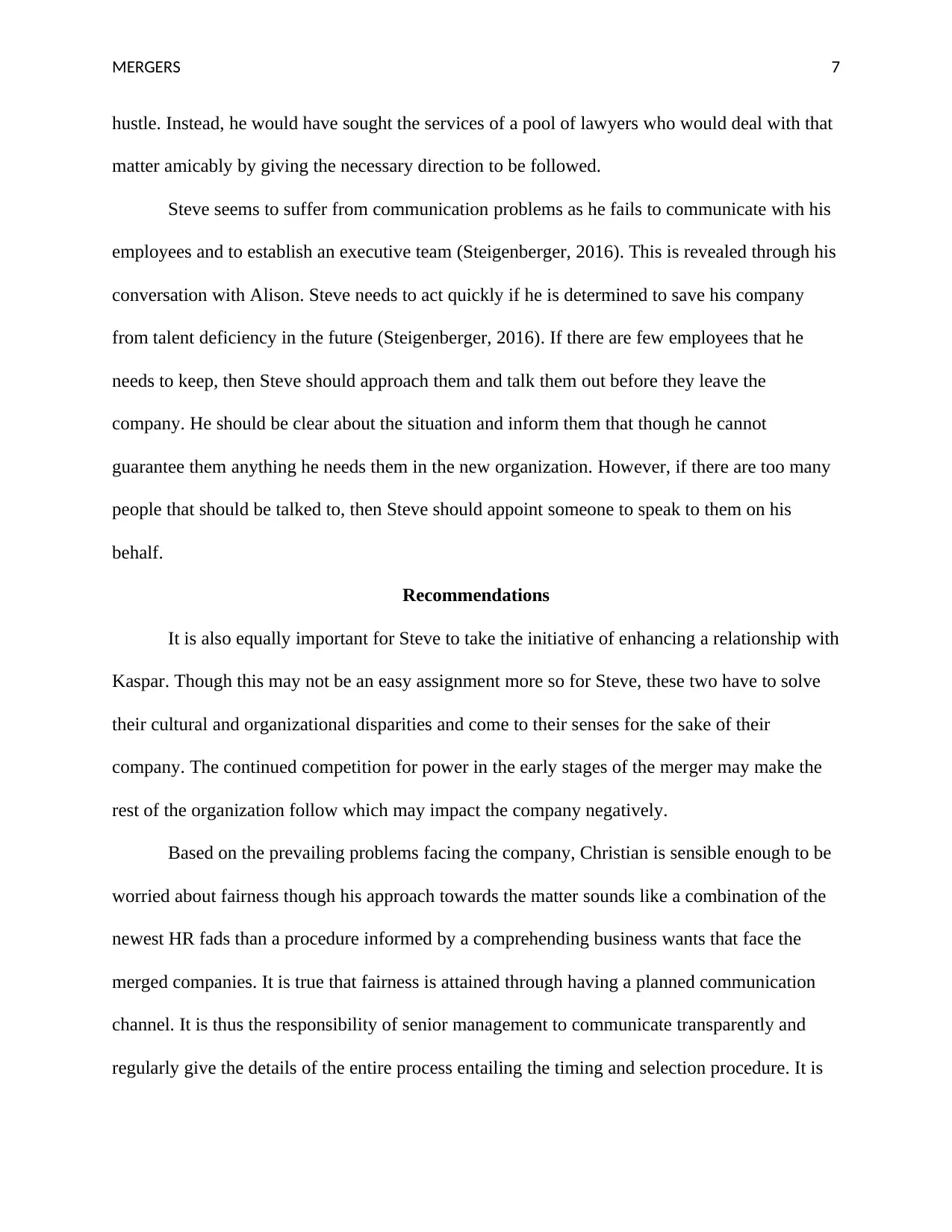
MERGERS 7
hustle. Instead, he would have sought the services of a pool of lawyers who would deal with that
matter amicably by giving the necessary direction to be followed.
Steve seems to suffer from communication problems as he fails to communicate with his
employees and to establish an executive team (Steigenberger, 2016). This is revealed through his
conversation with Alison. Steve needs to act quickly if he is determined to save his company
from talent deficiency in the future (Steigenberger, 2016). If there are few employees that he
needs to keep, then Steve should approach them and talk them out before they leave the
company. He should be clear about the situation and inform them that though he cannot
guarantee them anything he needs them in the new organization. However, if there are too many
people that should be talked to, then Steve should appoint someone to speak to them on his
behalf.
Recommendations
It is also equally important for Steve to take the initiative of enhancing a relationship with
Kaspar. Though this may not be an easy assignment more so for Steve, these two have to solve
their cultural and organizational disparities and come to their senses for the sake of their
company. The continued competition for power in the early stages of the merger may make the
rest of the organization follow which may impact the company negatively.
Based on the prevailing problems facing the company, Christian is sensible enough to be
worried about fairness though his approach towards the matter sounds like a combination of the
newest HR fads than a procedure informed by a comprehending business wants that face the
merged companies. It is true that fairness is attained through having a planned communication
channel. It is thus the responsibility of senior management to communicate transparently and
regularly give the details of the entire process entailing the timing and selection procedure. It is
hustle. Instead, he would have sought the services of a pool of lawyers who would deal with that
matter amicably by giving the necessary direction to be followed.
Steve seems to suffer from communication problems as he fails to communicate with his
employees and to establish an executive team (Steigenberger, 2016). This is revealed through his
conversation with Alison. Steve needs to act quickly if he is determined to save his company
from talent deficiency in the future (Steigenberger, 2016). If there are few employees that he
needs to keep, then Steve should approach them and talk them out before they leave the
company. He should be clear about the situation and inform them that though he cannot
guarantee them anything he needs them in the new organization. However, if there are too many
people that should be talked to, then Steve should appoint someone to speak to them on his
behalf.
Recommendations
It is also equally important for Steve to take the initiative of enhancing a relationship with
Kaspar. Though this may not be an easy assignment more so for Steve, these two have to solve
their cultural and organizational disparities and come to their senses for the sake of their
company. The continued competition for power in the early stages of the merger may make the
rest of the organization follow which may impact the company negatively.
Based on the prevailing problems facing the company, Christian is sensible enough to be
worried about fairness though his approach towards the matter sounds like a combination of the
newest HR fads than a procedure informed by a comprehending business wants that face the
merged companies. It is true that fairness is attained through having a planned communication
channel. It is thus the responsibility of senior management to communicate transparently and
regularly give the details of the entire process entailing the timing and selection procedure. It is
Paraphrase This Document
Need a fresh take? Get an instant paraphrase of this document with our AI Paraphraser
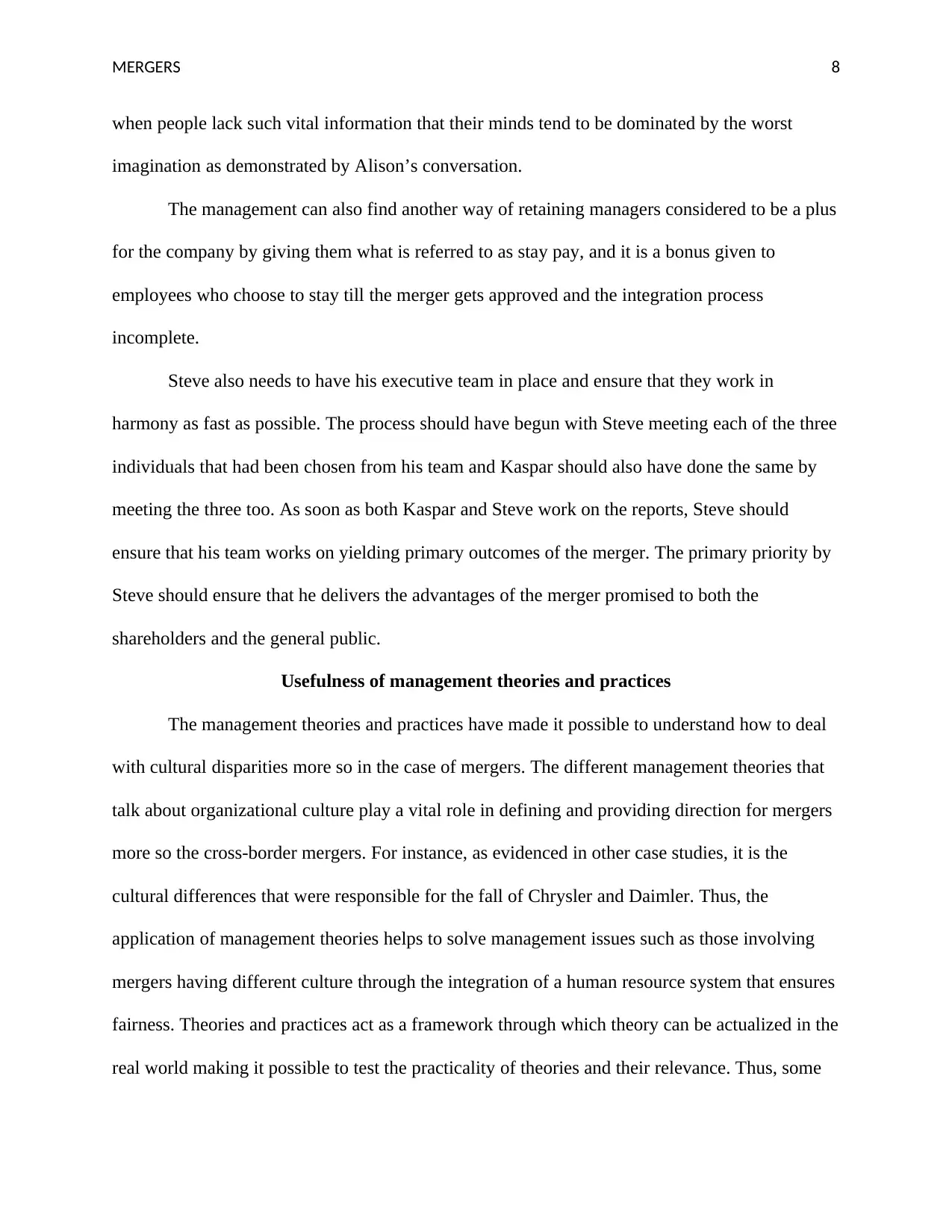
MERGERS 8
when people lack such vital information that their minds tend to be dominated by the worst
imagination as demonstrated by Alison’s conversation.
The management can also find another way of retaining managers considered to be a plus
for the company by giving them what is referred to as stay pay, and it is a bonus given to
employees who choose to stay till the merger gets approved and the integration process
incomplete.
Steve also needs to have his executive team in place and ensure that they work in
harmony as fast as possible. The process should have begun with Steve meeting each of the three
individuals that had been chosen from his team and Kaspar should also have done the same by
meeting the three too. As soon as both Kaspar and Steve work on the reports, Steve should
ensure that his team works on yielding primary outcomes of the merger. The primary priority by
Steve should ensure that he delivers the advantages of the merger promised to both the
shareholders and the general public.
Usefulness of management theories and practices
The management theories and practices have made it possible to understand how to deal
with cultural disparities more so in the case of mergers. The different management theories that
talk about organizational culture play a vital role in defining and providing direction for mergers
more so the cross-border mergers. For instance, as evidenced in other case studies, it is the
cultural differences that were responsible for the fall of Chrysler and Daimler. Thus, the
application of management theories helps to solve management issues such as those involving
mergers having different culture through the integration of a human resource system that ensures
fairness. Theories and practices act as a framework through which theory can be actualized in the
real world making it possible to test the practicality of theories and their relevance. Thus, some
when people lack such vital information that their minds tend to be dominated by the worst
imagination as demonstrated by Alison’s conversation.
The management can also find another way of retaining managers considered to be a plus
for the company by giving them what is referred to as stay pay, and it is a bonus given to
employees who choose to stay till the merger gets approved and the integration process
incomplete.
Steve also needs to have his executive team in place and ensure that they work in
harmony as fast as possible. The process should have begun with Steve meeting each of the three
individuals that had been chosen from his team and Kaspar should also have done the same by
meeting the three too. As soon as both Kaspar and Steve work on the reports, Steve should
ensure that his team works on yielding primary outcomes of the merger. The primary priority by
Steve should ensure that he delivers the advantages of the merger promised to both the
shareholders and the general public.
Usefulness of management theories and practices
The management theories and practices have made it possible to understand how to deal
with cultural disparities more so in the case of mergers. The different management theories that
talk about organizational culture play a vital role in defining and providing direction for mergers
more so the cross-border mergers. For instance, as evidenced in other case studies, it is the
cultural differences that were responsible for the fall of Chrysler and Daimler. Thus, the
application of management theories helps to solve management issues such as those involving
mergers having different culture through the integration of a human resource system that ensures
fairness. Theories and practices act as a framework through which theory can be actualized in the
real world making it possible to test the practicality of theories and their relevance. Thus, some
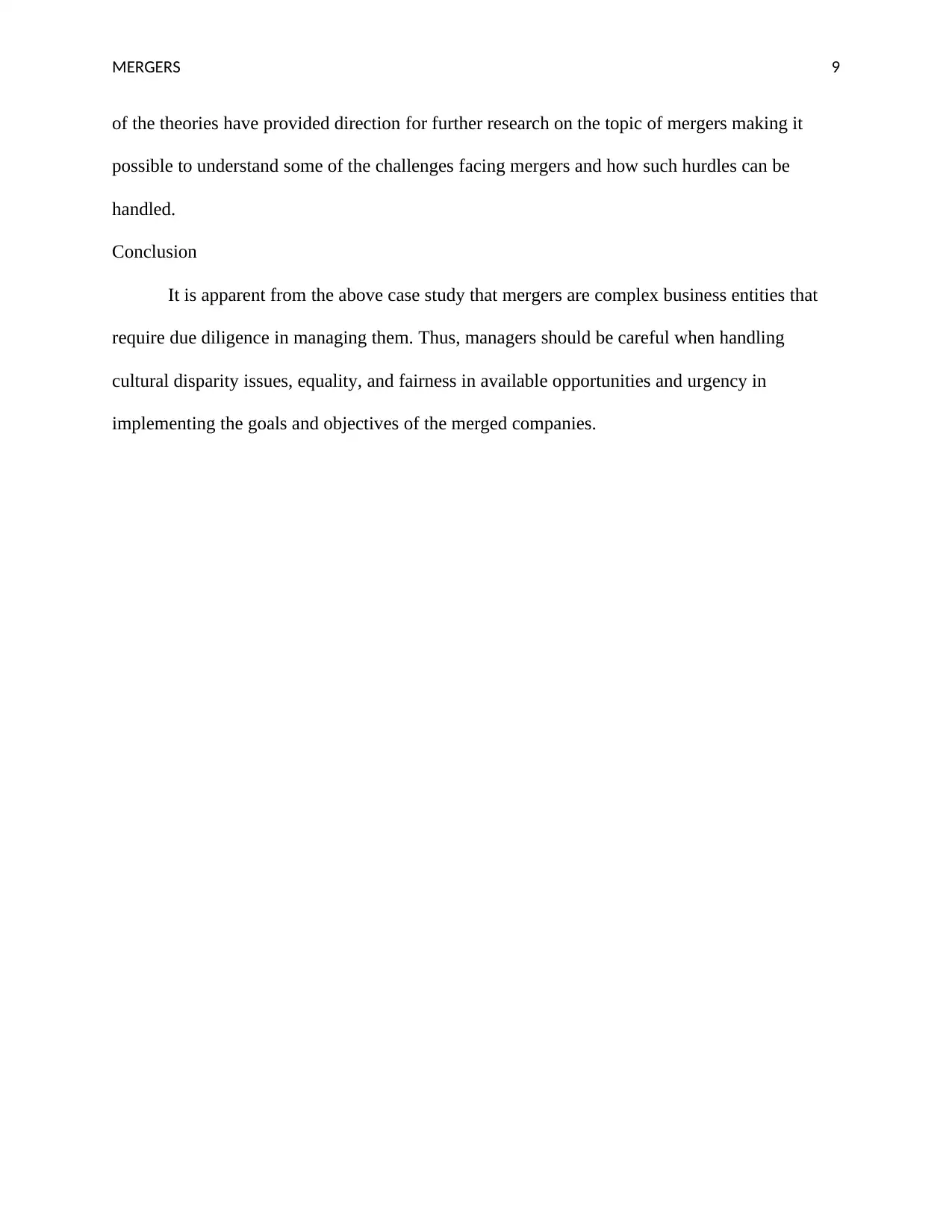
MERGERS 9
of the theories have provided direction for further research on the topic of mergers making it
possible to understand some of the challenges facing mergers and how such hurdles can be
handled.
Conclusion
It is apparent from the above case study that mergers are complex business entities that
require due diligence in managing them. Thus, managers should be careful when handling
cultural disparity issues, equality, and fairness in available opportunities and urgency in
implementing the goals and objectives of the merged companies.
of the theories have provided direction for further research on the topic of mergers making it
possible to understand some of the challenges facing mergers and how such hurdles can be
handled.
Conclusion
It is apparent from the above case study that mergers are complex business entities that
require due diligence in managing them. Thus, managers should be careful when handling
cultural disparity issues, equality, and fairness in available opportunities and urgency in
implementing the goals and objectives of the merged companies.
⊘ This is a preview!⊘
Do you want full access?
Subscribe today to unlock all pages.

Trusted by 1+ million students worldwide
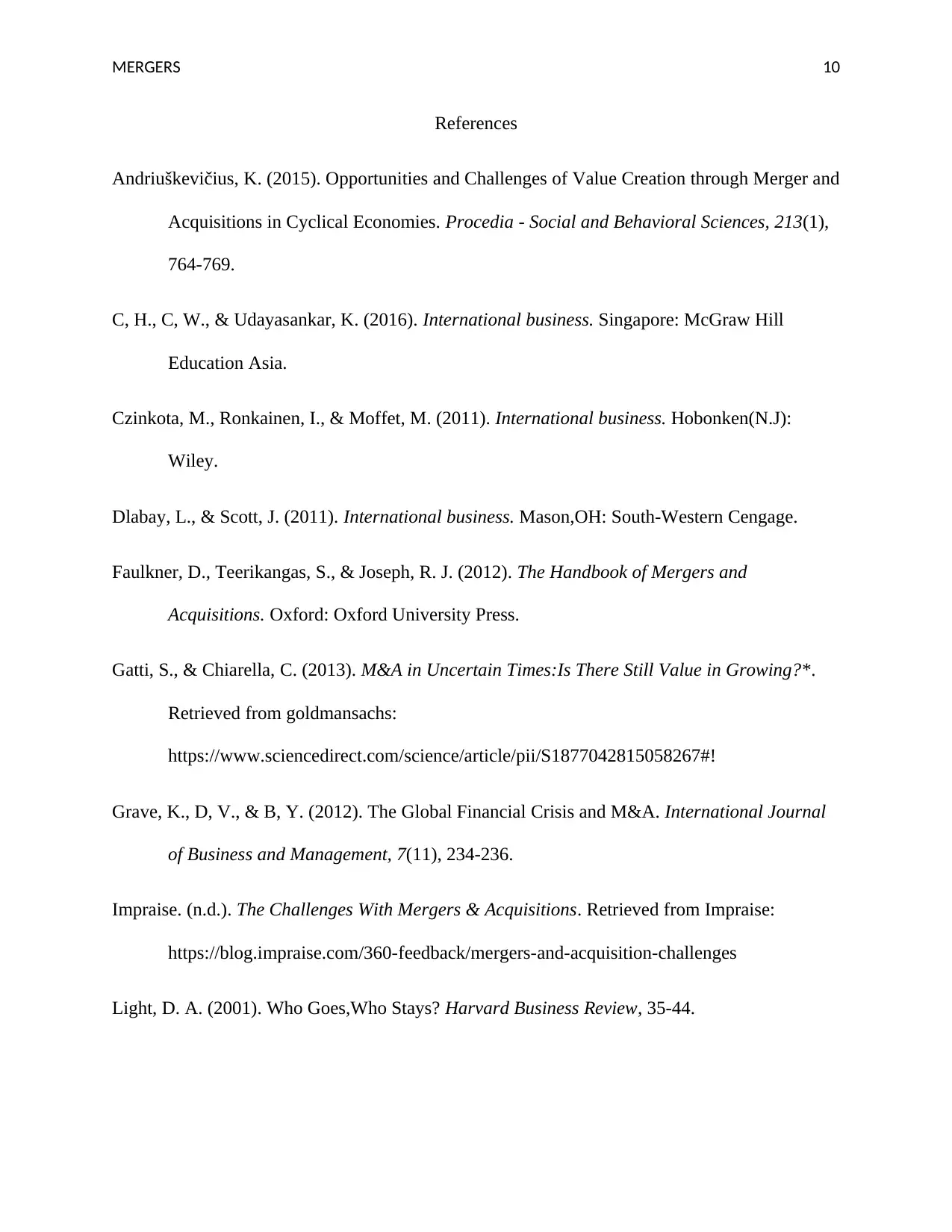
MERGERS 10
References
Andriuškevičius, K. (2015). Opportunities and Challenges of Value Creation through Merger and
Acquisitions in Cyclical Economies. Procedia - Social and Behavioral Sciences, 213(1),
764-769.
C, H., C, W., & Udayasankar, K. (2016). International business. Singapore: McGraw Hill
Education Asia.
Czinkota, M., Ronkainen, I., & Moffet, M. (2011). International business. Hobonken(N.J):
Wiley.
Dlabay, L., & Scott, J. (2011). International business. Mason,OH: South-Western Cengage.
Faulkner, D., Teerikangas, S., & Joseph, R. J. (2012). The Handbook of Mergers and
Acquisitions. Oxford: Oxford University Press.
Gatti, S., & Chiarella, C. (2013). M&A in Uncertain Times:Is There Still Value in Growing?*.
Retrieved from goldmansachs:
https://www.sciencedirect.com/science/article/pii/S1877042815058267#!
Grave, K., D, V., & B, Y. (2012). The Global Financial Crisis and M&A. International Journal
of Business and Management, 7(11), 234-236.
Impraise. (n.d.). The Challenges With Mergers & Acquisitions. Retrieved from Impraise:
https://blog.impraise.com/360-feedback/mergers-and-acquisition-challenges
Light, D. A. (2001). Who Goes,Who Stays? Harvard Business Review, 35-44.
References
Andriuškevičius, K. (2015). Opportunities and Challenges of Value Creation through Merger and
Acquisitions in Cyclical Economies. Procedia - Social and Behavioral Sciences, 213(1),
764-769.
C, H., C, W., & Udayasankar, K. (2016). International business. Singapore: McGraw Hill
Education Asia.
Czinkota, M., Ronkainen, I., & Moffet, M. (2011). International business. Hobonken(N.J):
Wiley.
Dlabay, L., & Scott, J. (2011). International business. Mason,OH: South-Western Cengage.
Faulkner, D., Teerikangas, S., & Joseph, R. J. (2012). The Handbook of Mergers and
Acquisitions. Oxford: Oxford University Press.
Gatti, S., & Chiarella, C. (2013). M&A in Uncertain Times:Is There Still Value in Growing?*.
Retrieved from goldmansachs:
https://www.sciencedirect.com/science/article/pii/S1877042815058267#!
Grave, K., D, V., & B, Y. (2012). The Global Financial Crisis and M&A. International Journal
of Business and Management, 7(11), 234-236.
Impraise. (n.d.). The Challenges With Mergers & Acquisitions. Retrieved from Impraise:
https://blog.impraise.com/360-feedback/mergers-and-acquisition-challenges
Light, D. A. (2001). Who Goes,Who Stays? Harvard Business Review, 35-44.
Paraphrase This Document
Need a fresh take? Get an instant paraphrase of this document with our AI Paraphraser
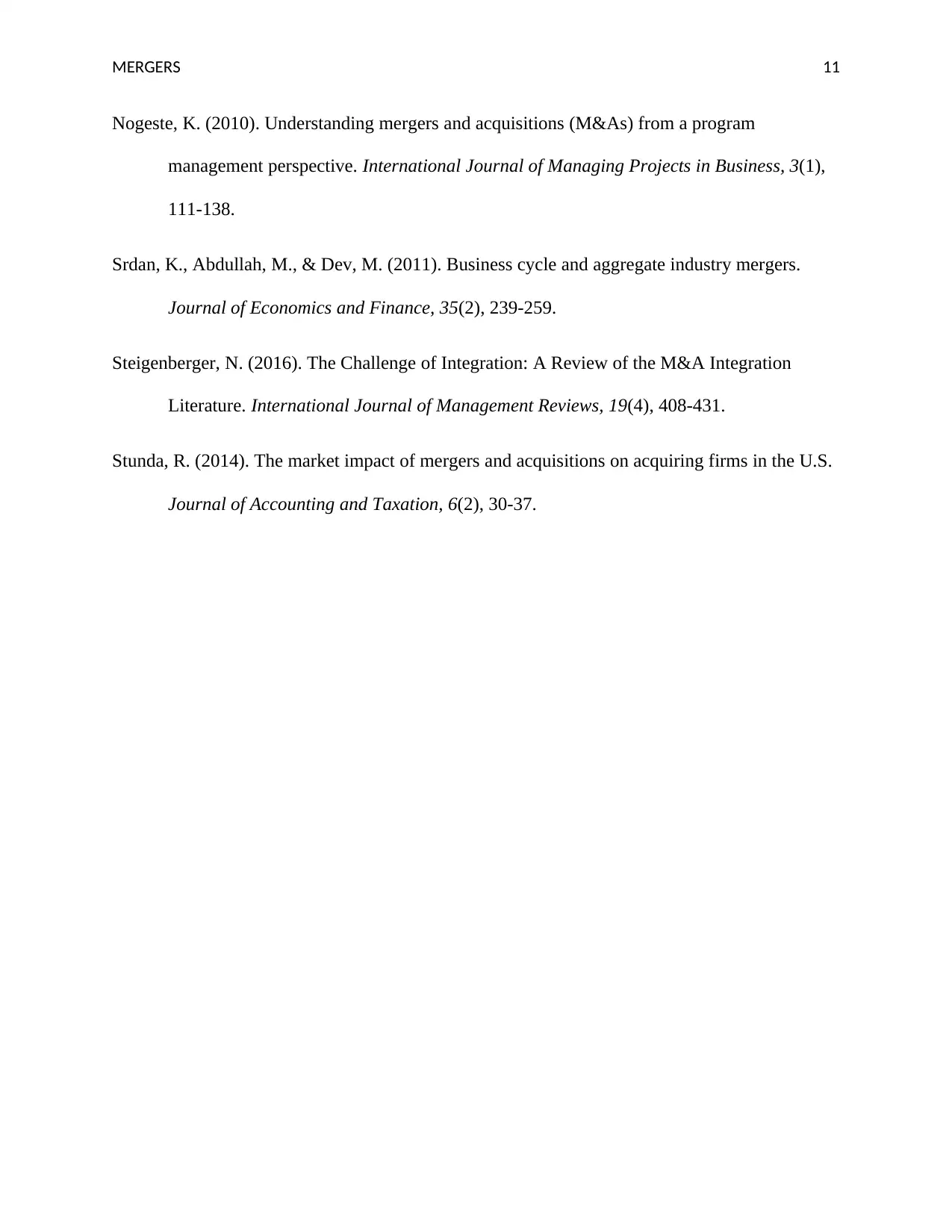
MERGERS 11
Nogeste, K. (2010). Understanding mergers and acquisitions (M&As) from a program
management perspective. International Journal of Managing Projects in Business, 3(1),
111-138.
Srdan, K., Abdullah, M., & Dev, M. (2011). Business cycle and aggregate industry mergers.
Journal of Economics and Finance, 35(2), 239-259.
Steigenberger, N. (2016). The Challenge of Integration: A Review of the M&A Integration
Literature. International Journal of Management Reviews, 19(4), 408-431.
Stunda, R. (2014). The market impact of mergers and acquisitions on acquiring firms in the U.S.
Journal of Accounting and Taxation, 6(2), 30-37.
Nogeste, K. (2010). Understanding mergers and acquisitions (M&As) from a program
management perspective. International Journal of Managing Projects in Business, 3(1),
111-138.
Srdan, K., Abdullah, M., & Dev, M. (2011). Business cycle and aggregate industry mergers.
Journal of Economics and Finance, 35(2), 239-259.
Steigenberger, N. (2016). The Challenge of Integration: A Review of the M&A Integration
Literature. International Journal of Management Reviews, 19(4), 408-431.
Stunda, R. (2014). The market impact of mergers and acquisitions on acquiring firms in the U.S.
Journal of Accounting and Taxation, 6(2), 30-37.
1 out of 11
Related Documents
Your All-in-One AI-Powered Toolkit for Academic Success.
+13062052269
info@desklib.com
Available 24*7 on WhatsApp / Email
![[object Object]](/_next/static/media/star-bottom.7253800d.svg)
Unlock your academic potential
Copyright © 2020–2025 A2Z Services. All Rights Reserved. Developed and managed by ZUCOL.




